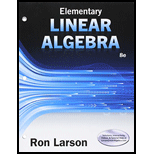
Concept explainers
True or False? In Exercises 49 and 50, determine whether each statement is true or false. If a statement is true, give a reason or cite an appropriate statement from the text. If a statement is false, provide an example that shows the statement is not true in all cases or cite an appropriate statement from the text.
(a) A vector space consists of four entities: a set of
(c) The set of all ordered triples
Want to see the full answer?
Check out a sample textbook solution
Chapter 4 Solutions
Bundle: Elementary Linear Algebra, Loose-leaf Version, 8th + MindTap Math, 1 term (6 months) Printed Access Card
- 4. Select all of the solutions for x²+x - 12 = 0? A. -12 B. -4 C. -3 D. 3 E 4 F 12 4 of 10arrow_forward2. Select all of the polynomials with the degree of 7. A. h(x) = (4x + 2)³(x − 7)(3x + 1)4 B h(x) = (x + 7)³(2x + 1)^(6x − 5)² ☐ Ch(x)=(3x² + 9)(x + 4)(8x + 2)ª h(x) = (x + 6)²(9x + 2) (x − 3) h(x)=(-x-7)² (x + 8)²(7x + 4)³ Scroll down to see more 2 of 10arrow_forward1. If all of the zeros for a polynomial are included in the graph, which polynomial could the graph represent? 100 -6 -2 0 2 100 200arrow_forward
- 3. Select the polynomial that matches the description given: Zero at 4 with multiplicity 3 Zero at −1 with multiplicity 2 Zero at -10 with multiplicity 1 Zero at 5 with multiplicity 5 ○ A. P(x) = (x − 4)³(x + 1)²(x + 10)(x — 5)³ B - P(x) = (x + 4)³(x − 1)²(x − 10)(x + 5)³ ○ ° P(x) = (1 − 3)'(x + 2)(x + 1)"'" (x — 5)³ 51 P(r) = (x-4)³(x − 1)(x + 10)(x − 5 3 of 10arrow_forwardMatch the equation, graph, and description of transformation. Horizontal translation 1 unit right; vertical translation 1 unit up; vertical shrink of 1/2; reflection across the x axis Horizontal translation 1 unit left; vertical translation 1 unit down; vertical stretch of 2 Horizontal translation 2 units right; reflection across the x-axis Vertical translation 1 unit up; vertical stretch of 2; reflection across the x-axis Reflection across the x - axis; vertical translation 2 units down Horizontal translation 2 units left Horizontal translation 2 units right Vertical translation 1 unit down; vertical shrink of 1/2; reflection across the x-axis Vertical translation 2 units down Horizontal translation 1 unit left; vertical translation 2 units up; vertical stretch of 2; reflection across the x - axis f(x) = - =-½ ½ (x − 1)²+1 f(x) = x²-2 f(x) = -2(x+1)²+2 f(x)=2(x+1)²-1 f(x)=-(x-2)² f(x)=(x-2)² f(x) = f(x) = -2x²+1 f(x) = -x²-2 f(x) = (x+2)²arrow_forwardWhat is the vertex, increasing interval, decreasing interval, domain, range, root/solution/zero, and the end behavior?arrow_forward
- The augmented matrix of a linear system has been reduced by row operations to the form shown. Continue the appropriate row operations and describe the solution set of the original system. 1 -1 0 1 -2 00-4 0-6 0 0 1 - 3 3 0 001 4arrow_forwardSolve the system. X1 - 3x3 = 10 4x1 + 2x2 + 3x3 = 22 ×2 + 4x3 = -2arrow_forwardUse the quadratic formula to find the zeros of the quadratic equation. Y=3x^2+48x+180arrow_forward
- M = log The formula determines the magnitude of an earthquake, where / is the intensity of the earthquake and S is the intensity of a "standard earthquake." How many times stronger is an earthquake with a magnitude of 8 than an earthquake with a magnitude of 6? Show your work.arrow_forwardNow consider equations of the form ×-a=v = √bx + c, where a, b, and c are all positive integers and b>1. (f) Create an equation of this form that has 7 as a solution and an extraneous solution. Give the extraneous solution. (g) What must be true about the value of bx + c to ensure that there is a real number solution to the equation? Explain.arrow_forwardThe equation ×+ 2 = √3x+10 is of the form ×+ a = √bx + c, where a, b, and c are all positive integers and b > 1. Using this equation as a model, create your own equation that has extraneous solutions. (d) Using trial and error with numbers for a, b, and c, create an equation of the form x + a = √bx + c, where a, b, and c are all positive integers and b>1 such that 7 is a solution and there is an extraneous solution. (Hint: Substitute 7 for x, and choose a value for a. Then square both sides so you can choose a, b, and c that will make the equation true.) (e) Solve the equation you created in Part 2a.arrow_forward
- Algebra & Trigonometry with Analytic GeometryAlgebraISBN:9781133382119Author:SwokowskiPublisher:Cengage
 Elementary Linear Algebra (MindTap Course List)AlgebraISBN:9781305658004Author:Ron LarsonPublisher:Cengage Learning
Elementary Linear Algebra (MindTap Course List)AlgebraISBN:9781305658004Author:Ron LarsonPublisher:Cengage Learning Trigonometry (MindTap Course List)TrigonometryISBN:9781337278461Author:Ron LarsonPublisher:Cengage Learning
Trigonometry (MindTap Course List)TrigonometryISBN:9781337278461Author:Ron LarsonPublisher:Cengage Learning


